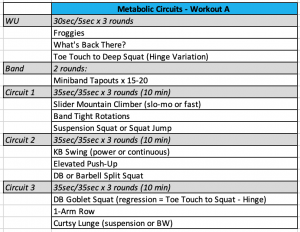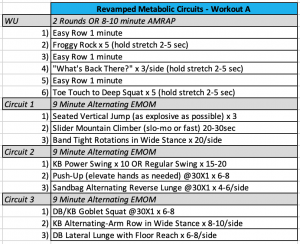Workout Revamp: 2017 vs 2019 v1.0
By Sarah Rippel
author of Build ‘N Burn & the upcoming “Ultimate Group Training Manual”
I encourage anyone who may be feeling uninspired with their present programming to take a look back at some older work. You may find that in taking some old programs and upgrading them, you discover exercises, circuits, or tweaks you had forgotten about.
In addition, you may find the process of dusting off some old programs to be empowering! You undoubtedly will have moments where you realize how your methods have evolved and improved over time.
A few weeks ago, I shared a template in the private Facebook group we created for fit pros who purchased Build ‘N Burn . This template outlined a few weeks of metabolic workouts I programmed for my groups in 2017.
I wanted to share a few of those workouts and show how I would tweak them based on my present way of doing things!
Without further ado, let’s take a look at “Workout A” from 2017’s Block 1.
This workout starts with a ground-based warm-up that emphasizes mobility. I programmed this sequence using timed intervals of 30 seconds work paired with 5 seconds rest.
Although I feel this little sequence is pretty solid, it could be tweaked to include a dynamic component to get heart rates up a bit more.

Revamped Version:

An alternative could be:
Warm-Up: 2 Rounds OR 8-10 minute AMRAP
- Easy Row 1 minute
- Froggy Rock x 5 (hold stretch 2-5 sec)
- Easy Row 1 minute
- “What’s Back There?” x 3/side (hold stretch 2-5 sec)
- Easy Row 1 minute
- Toe Touch to Deep Squat x 5 (hold stretch 2-5 sec)
*Note: the “what’s back there” is basically a stretch done in quadruped position for the sides of the body. All you do is attempt to look back behind you as you exhale, without losing your spinal position or neutral pelvis. You will feel a stretch on the opposite side.
Moving on, part of me wanted to place the Miniband Tap-Outs into one of the circuits instead of having them be a separate aspect of the workout. I opted to remove them from the upgraded workout.
For Circuits 1, 2, and 3, I tweaked them to be EMOMs instead of timed intervals? Why? This allows for more tweaks to suit the individuals in the group this way. It’s an easy way for some people can “go harder” if they feel like it that day. This can be done by giving options for reps or time, in addition to options for intensifying the exercises.
Also, looking at the first circuit, programming 35 seconds of squat jumps is just not how I roll these days. It just seems silly. I would rather have someone perform 3-5 reps of an all-out explosive movement rather than sloppy reps done for time. I understand why I programmed the original workout this way, because I was using timed intervals and it had to fit within that framework, but I feel there are better ways to get the job done.
Here’s upgrades for the rest of the workout:
Circuit 1: 9 minute Alternating EMOM
- Seated Vertical Jump – x 3 reps, as explosive as possible
- Slider Mountain Climber (slo-mo or fast) – 20-30 seconds
- Band Tight Rotations in Wide Stance – 20/side
I moved the explosive movement to the first in the circuit. In addition, I moved the Slider Mountain Climber to the second position. This sequencing just makes more sense to me and is similar to that of the second circuit.
I believe that plyometric work should be done as explosively as possible for low reps. Low-level plyos such as jump rope, pogos, etc can be done for higher reps/duration. I opted to change the Suspension Squat Jumps to a Seated Vertical Jump for three reps. When a person puts everything into those three explosive reps, they engage their entire body and will get more out of the movement than if they are performing an unspecified number of reps within a timed interval.
I have found that having people perform the Band Tight Rotations with their feet wide facilitates a better outcome in terms of performance! The wide setup minimizes the amount of rotation at the hips and thus enables the person to perform better reps, focusing on driving the arms side to side.
Circuit 2: 9 minute Alternating EMOM
- Kettlebell Power Swing x 5-10 OR Regular Swing x 15-20
- Push-Up (elevate hands as needed) @30X1 tempo x 6-8
- Sandbag Alternating Reverse Lunge @30X1 tempo x 4-6/side
The KB Power Swing is shown in the linked video. Each rep begins & ends with the kettlebell on the floor. I really like this variation because it demands a proper set-up for each rep. Because each rep begins from a dead stop, the body must generate a great amount of power every time, which I feel keeps technique cleaner compared to a regular swing. I feel people can get sloppy with regular swings if they aren’t focusing.
Using a tempo focus with the push-ups gives people a focus. It prevents people from attempting to churn out sloppy reps at breakneck speed! I believe being able to nail 6-8 solid reps at a controlled tempo is a much better opportunity for people than allowing them to knock out reps for 35 seconds.
I prefer to load split squats and lunges with racked kettlebells or a sandbag these days because I feel it allows people to maintain better posture. The anterior load facilitates proper bracing of the core and tends to reduce the ability to hyperextend at the lumbar spine. I switched the original split squat to an alternating reverse lunge so that continuous reps could be performed. As with the push-ups, using a tempo focus with the Sandbag Alternating Reverse Lunge gives people a focus. The 3-second eccentric slows people down and thus cleans up the movement.
Circuit 3: 9 minute Alternating EMOM
- DB/KB Goblet Squat @30X1 x 6-8
- KB Alternating-Arm Row in Wide Stance x 8-10/side
- DB Lateral Lunge with Floor Reach x 6-8/side
By giving the Goblet Squat a tempo focus, it allows for better performance as mentioned above! In addition, less loading may be necessary because the slower eccentric provides an extra challenge to the body.
Performing the KB Row in a wide stance with an alternating-arm manner enables participants to focus on a continuous, controlled movement without having to think about switching sides. In addition, the wide stance is unsupported and thus requires more core and hip engagement to hold the position. More bang for your buck!
Last, I decided to do away with the curtsy lunge and instead opted for a lateral lunge. This movement is more hip-focused in that the addition of a floor reach is a hinge action. I do not feel that the curtsy lunge is best for everyone, as those with cranky knees may have a problem with it. The DB Lateral Lunge with Floor Reach is a winner!
There you have it! A rationale for tweaking a workout based on my present thought process. If you are finding yourself uninspired in your programming, take a look back at some programs from the past and see what you can do to modify them! I guarantee the process will be eye-opening and get your program design gears turning!
Go grab Build N’ Burn – Done For YOU Metabolic Small Group Training System for Fit Pros
——————————————————————————————————
Other articles by Sarah Rippel:
Unconventional Cardio: Strongman Conditioning Circuits
Density Training for Metabolic Conditioning & Strength Work
Using Cluster Sets To Spice Up Strength Programming
4 Wall Ball Conditioning Workouts+4 Tips to Improve Wall Ball Technique(Videos)
Using a Tempo Focus with Build ‘N Burn Workouts
Speed Ladder + Static Core Continuous 30-Second Circuit Version 2.0
The Continuous 20-Second Interval Format
(“BURN” Circuits w/ Videos )

